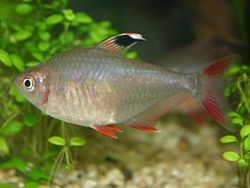Characiformes
| Characiformes
| ||||||||
|---|---|---|---|---|---|---|---|---|
 Hyphessobrycon bentosi
| ||||||||
| Scientific classification | ||||||||
| ||||||||
|
Acestrorhynchidae |
Characiformes is a diverse order of ray-finned fish, comprising the characins and their allies. There are a few thousand different species, including the well-known piranha and tetras.[1]
Taxonomy
Characiformes is part of a series called Otophysi within the superorder Ostariophysi. Otophysi contains four other orders, Cypriniformes, Siluriformes, and Gymnotiformes.[1] Characiformes forms a group known as Characaphysi with Siluriformes and Gymnotiformes.[2] Characiformes is the sister group to the orders Siluriformes and Gymnotiformes, though this has been debated in light of recent molecular evidence.[1]
Originally the characins were all grouped within a single family, the Characidae, which was included in the Cypriniformes.[citation needed] Since then about 15 different families have been separated out. However, classification varies somewhat, and it appears the circumscribed Characidae are still polyphyletic.[citation needed] Currently, there are eighteen families, about 270 genera, and at least 1674 species.[1] The suborder Citharinoidei, which contains the families Distichodontidae and Citharinidae, is considered the sister group to the rest of the characins, suborder Characoidei.[2]
Evolution
The oldest characiform is Satanichthys of the early Cretaceous (Albian stage) of Brazil. While all extant species are freshwater, this species was probably either brackish or marine. Many other fossils are also known.[1] Characiformes likely first diversified during the Cretaceous period, though fossils are poorly known.[1] During the Cretaceous period, the rift between South America and Africa would be forming; this may explain the contrast in diversity between the two continents. Their low diversity in Africa may explain why some primitive fish families and Cypriniformes coexist with them while they are absent in South America, where these fish may have been driven extinct.[2] The characiforms had not spread into Africa soon enough to also reach the land bridge between Africa and Asia.[2] The earliest they could have spread into Central America was the late Miocene.[2]
Distribution
Characins are most diverse in the Neotropics, where they are found in tropical lakes and rivers throughout most of South America, Central America, and central Africa. At least 209 species of characins are found in Africa, including the distichodontids, the citharinids, the alestiids, and the monotypic Hepsetidae, Hepsetus odoe. The rest of the characins originate from the Americas.[1]
Appearance and anatomy
These belong within the series Otophysi, a group mainly distinguished by the presence of a Weberian apparatus, a series of bony parts connecting the swim bladder and inner ear.[1] Superficially, the Characiformes somewhat resemble their relatives of the order Cypriniformes. One noticeable difference is the presence of a small fleshy adipose fin between the dorsal fin and tail. The presence of teeth within the mouth is also often present as most (though not all species) are carnivorous. However, there are exceptions to both of these. Barbels are always absent and the body is almost always covered in well-defined scales. The mouth is also usually not truly protractile.[3]
The largest size is 1.4 metres (4.5 ft) reached in Hydrocynus goliath, while the smallest size is about 13 millimetres (.5 in). Many members are under 3 centimetres (about 1 in).[1]
Relationship to humans
A few characins become quite large, and are important as food or game.[1] Most, however, are small shoaling fish. Many species known as tetras are popular in aquaria thanks to their bright colors, general hardiness, and tolerance towards other fish in community tanks.[1]
ReferencesISBN links support NWE through referral fees
- ↑ 1.00 1.01 1.02 1.03 1.04 1.05 1.06 1.07 1.08 1.09 1.10 1.11 Nelson, Joseph, S. (2006). Fishes of the World. John Wiley & Sons, Inc..
- ↑ 2.0 2.1 2.2 2.3 2.4 Briggs, John C. (2005). The biogeography of otophysan fishes (Ostariophysi: Otophysi): a new appraisal. Journal of Biogeography 32: 287–294.
- ↑ "Characiformes". FishBase. Ed. Ranier Froese and Daniel Pauly. Feb 2007 version. N.p.: FishBase, 2007.
- Nelson, J. S. 2006. Fishes of the World, 4th edition. Hoboken, NJ: John Wiley & Sons. ISBN 0471250317.
| |||||||||||
Credits
New World Encyclopedia writers and editors rewrote and completed the Wikipedia article in accordance with New World Encyclopedia standards. This article abides by terms of the Creative Commons CC-by-sa 3.0 License (CC-by-sa), which may be used and disseminated with proper attribution. Credit is due under the terms of this license that can reference both the New World Encyclopedia contributors and the selfless volunteer contributors of the Wikimedia Foundation. To cite this article click here for a list of acceptable citing formats.The history of earlier contributions by wikipedians is accessible to researchers here:
The history of this article since it was imported to New World Encyclopedia:
Note: Some restrictions may apply to use of individual images which are separately licensed.